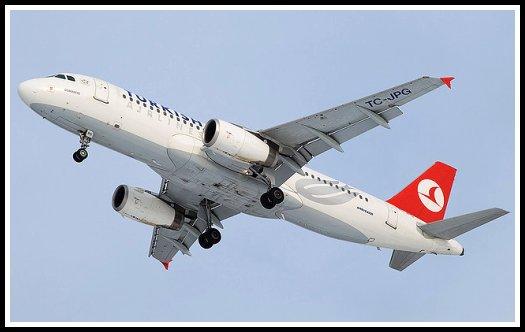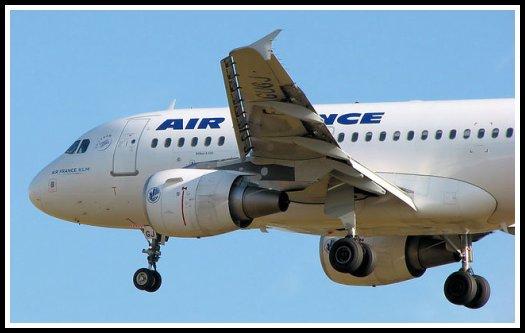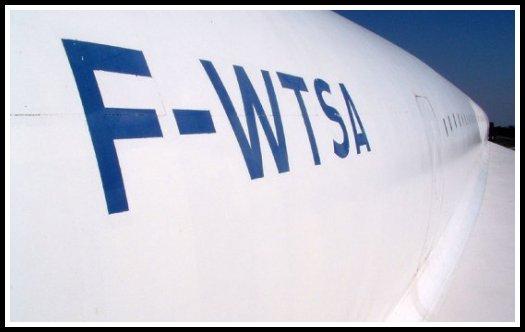Aircraft call-signs explained
Air Force One, I told you to expedite.
- ORD ATC.

Turkish Airlines Airbus A320 after take-off
Call-signs
A prerequisite to safe air traffic separation is the assignment and use of distinctive call signs. These are permanently allocated by ICAO (pronounced "ai-kay-oh") on request usually to scheduled flights and some air forces for military flights. They are written call-signs with 3-letter combination like KLM, BAW, VLG followed by the flight number, like AAL872, VLG1011. As such they appear on flight plans and ATC radar labels. There are also the audio or radio-telephony call-signs used on the radio contact between pilots and Air Traffic Control not always identical with the written ones. For example BAW symbolises British Airways but on the radio you will only hear the word Speedbird followed by an alpha-numeric code instead. By default, the call-sign for any other flight is the registration number (tail number) of the aircraft, such as "N12345", "C-GABC" or "EC-IZD". The term tail number is because a registration number is usually painted somewhere on the tail of a plane, yet this is not a rule. Registration numbers may appear on the engines, anywhere on the fuselage, and often on the wings. The short radio-telephony call-signs for these tail numbers is the last 3 letters only like ABC spoken Alpha-Bravo-Charlie for C-GABC or the last 3 numbers like 345 spoken as TREE-FORE-FIFE for N12345. In the United States the abbreviation of call-signs is required to be a prefix (such as aircraft type, aircraft manufacturer, or first letter of registration) followed by the last three characters of the call-sign. This abbreviation is only allowed after communications has been established in each sector.
The flight number part is decided by the aircraft operator. In this arrangement, an identical call-sign might well be used for the same scheduled journey each day it is operated, even if the departure time varies a little across different days of the week. The call-sign of the return flight often differs only by the final digit from the outbound flight. Generally, airline flight numbers are even if eastbound, and odd if westbound. In order to reduce the possibility of two call-signs on one frequency at any time sounding too similar, a number of airlines, particularly in Europe, have started using alphanumeric call-signs that are not based on flight numbers. For example DLH23LG, spoken as lufthansa-two-tree-lima-golf. Additionally it is the right of the air traffic controller to change the 'audio' call-sign for the period the flight is in his sector if there is a risk of confusion, usually choosing the tail number instead.
Before around 1980 International Air Transport Association (IATA) and ICAO were using the same 2-letter call-signs. Due to the larger number of new airlines after deregulation ICAO established the 3-letter call-signs as mentioned above. The IATA call-signs are currently used in aerodromes on the announcement tables but never used any longer in Air Traffic Control. For example, AA is the IATA call-sign for American Airlines - ATC equivalent AAL. Other examples include LY/ELY for El Al, DL/DAL for Delta Air Lines, VY/VLG for Vueling Airlines, etc.
Call-signs in aviation are derived from several different policies, depending upon the type of flight operation and whether or not the caller is in an aircraft or at a ground facility. In most countries, unscheduled general aviation flights identify themselves using the call-sign corresponding to the aircraft's registration number (also called N-number in the U.S., or tail number). In this case, the call-sign is spoken using the International Civil Aviation Organization (ICAO) phonetic alphabet. Aircraft registration numbers internationally follow the pattern of a country prefix, followed by a unique identifier made up of letters and numbers. For example, an aircraft registered as N978CP conducting a general aviation flight would use the call-sign November-niner-seven-eight-Charlie-Papa. However, in the United States a pilot aircraft would normally omit saying November, since that would be assumed.
In most countries, the aircraft call-sign or "tail number" or registration marks are linked to the international radio call-sign allocation table and follow a convention that aircraft radio stations (and, by extension, the aircraft itself) receive call-signs consisting of five letters. For example, all British civil aircraft have a five-letter call-sign beginning with G. Canadian aircraft have a call-sign beginning with C–F or C–G, such as C–FABC. Wing In Ground-effect vehicles (hovercraft) in Canada are eligible to receive C–Hxxx call-signs, and ultralight aircraft receive C-Ixxx call-signs. In days gone by, even American aircraft used five letter call-signs, such as KH–ABC, but they were replaced prior to World War II by the current American system of aircraft call-signs.
The dash ("-") in the registration is only included on the fuselage of the airplane for readability. In air traffic management systems (ATC radar screen, flow management systems, etc.) and on flight plan forms, the dash is not used (e.g. PHVHA, FABCD, CFABC).
After an aircraft has made contact with an air traffic control facility, the call-sign may be abbreviated. Sometimes the aircraft make or model is used in front of the full or abbreviated call-sign, for instance, the American aircraft mentioned above might then use Cessna Eight-Charlie-Papa. Alternatively, the initial letter of the call-sign can be concatenated with the final two or three characters, for instance a British aircraft registered G–BFRM may identify as Golf–Romeo–Mike while the American aircraft might use November–Eight-Charlie-Papa. The use of abbreviated call-signs has its dangers, in the case when aircraft with similar call-signs are in the same vicinity. Therefore abbreviated signs are used only so long as it is unambiguous.
The United States does not follow the five-letter call-sign convention, and in that country the registration number begins with the letter N followed by up to five digits and/or letters in one of these schemes: one to five numbers (N12345), one to four numbers and one suffix letter (N1234Z), or one to three numbers and two suffix letters (N123AZ). The numeric part of the registration never starts with zero.

Commercial operators, including scheduled airline, air cargo and air taxi operators, will usually use an ICAO or FAA-registered call-sign for their company. By ICAO Annex 10 Chapter 5.2.1.7.2.1 - Full call-signs type C, a call-sign consists out of the telephony designator of the aircraft operating agency, followed by the flight identification. The flight identification is very often the same as the flight number, but could be different due to call-sign confusion, if two or more flights close to each other have similar flight numbers (i.e. KLM649 and KLM645 or BAW466 and BAW646). For example, British Airways flight 75 would use the call-sign Speedbird Seven–Five, since Speedbird is the telephony designator for British Airways and 75 would be the flight identification. (The telephony designator is not the same as the call-sign, although the two are sometimes conflated). Pan Am had the telephony designator of Clipper.
For these call-signs, proper usage varies by country. In some countries, such as the United States, numbers are spoken normally (for the example above, Speedbird Seventy-five) instead of being spelled out digit by digit, leading to the possibility of confusion. In most other countries, including the United Kingdom, they are spelled out. Air taxi operators in the United States sometimes do not have a registered call-sign, in which case the prefix T is used, followed by the aircraft registration number (e.g. Tango- November-Niner-Seven-Eight-Charlie-Papa).
Some variations of call-signs exist to express safety concerns to all operators and controllers monitoring the transmissions. Aircraft call-signs will use the suffix "heavy" for heavy aircraft, to indicate an aircraft that is going to cause significant wake turbulence, e.g. United Two-Five Heavy. All aircraft capable of operating with a gross take-off weight of more than 300,000 lbs. must use this suffix whether or not they are operating at this weight during a particular phase of flight. These are typically Boeing 747, some models of the 757, 777, or 767, Airbus A340, A330 and A300, McDonnell Douglas DC-10 or MD-11, or Lockheed L-1011 aircraft. The suffix "super" is used for the Airbus A380. For air ambulance services or other flights involving the safety of life (such as aircraft carrying a person who has suffered a heart attack), "lifeguard" is added to the call-sign. For flights in which life is not in direct danger (such as transporting organs for transplant), the call sign prefix "Pan-Pan-Medical" is used before the normal call-sign, e.g. Pan-Pan-Medical Three-Three-Alpha, Pan-Pan-Medical Northwest Four-Five-Eight, or Pan-Pan-Medical Singapore Niner-Two-Three. Pan Pan (pronounced "pahn-pahn") is the voice radio signal for "urgent", while Mayday is the voice radio signal for "distress". The word may be omitted for air ambulance services with assigned call-signs, especially when they have notified air traffic control operators that they are on an air ambulance mission at the beginning of their flight and do not change from one controller to another. The Life Flight air ambulance service, for example, might simply identify as Life-Flight Three. An aircraft that has declared an in-flight emergency will sometimes prefix the word Mayday to its call-sign.

A French Concorde with the registration F-WTSA
Formerly one of the rarest call-signs, "Concorde", was once used to identify British Airways Concorde aircraft. The intent of this call-sign was to raise the air traffic control operators' awareness of the unique performance of the aircraft and the special attention it required. The call-sign was appended to British Airways' normal radio call-sign, e.g. "Speedbird-Concorde One". In normal service, Air France did not use it at all. Its Concorde flights simply used the standard Air France call-sign.
Glider pilots often can use any of three different call-signs. Since most (not all) gliders now show standard CAA general aviation registrations e.g. G-xxxx they can call using the same call-sign and abbreviation rules as other light aircraft. This has long been in the case in the United States. Before these registrations came in (between 2004–2008) they used to use and normally still do use either a three letter code issued to all gliders by the British Gliding Association known as the aircraft's Trigraph e.g. XYZ normally calling ATC as "Glider X-ray, Yankee, Zulu" or if they paid extra could get from the BGA a numeric or mixed numeric and letter code known as a competition number for marking their aircraft and as a call-sign. For Example R4 "Romeo Four", or 26 "Two Six" or F1 "Foxtrot One". Optionally gliders will normally tag on the "Glider" in front of their call-sign when calling ATC units so that the controller knows for example that the glider will be unable to maintain a particular height as gliders are normally either descending in a straight glide or circling to climb. Some gliders are still not required to carry a CAA General Aviation type registration as they are older designs or prototypes and can therefore only continue to just use their Trigraph or Competition number as a call-sign. These are known as Annex II aircraft as they are listed in EASA Annex II.
Military flights often use more than one call-sign during a flight. Administrative call-signs are used with air traffic control facilities similar to those of commercial operators. e.g. Navy Alpha-Golf-Two-One, Reach-Three-One-Seven-Niner Two.
Tactical call-signs are used during tactical portions of a flight, and they often indicate the mission of the flight and/or an aircraft's position in a formation.
For example, Canadian Air Force 442 Rescue Squadron, based at Comox, British Columbia uses the call-sign "Snake 90x" depending on the tail number of the helicopter: 901, 902, etc. When tasked on a search and rescue (SAR) mission, however, the aircraft call-sign becomes "Rescue 90x".
Ground facilities identify themselves by the name and function of the facility: e.g. Seattle Tower for the tower air traffic control operators' position, SoCal Approach for a TRACON, or Boston Center for an Area Control Center. All other ICAO countries around the world, for example the European Joint Aviation Authorities (JAA), use Control or Radar instead of Center in their airspace. (Langen Radar, Brussels Control, Paris Control, ...). London Centre (center) is the emergency frequency call-sign for London Terminal Control TC.
The ICAO 24–bit transponder code is intended for non-human usage in the Mode-S and ADS-B protocols.
UTC | Zulu Time
Copyright © 2012 Roger. All rights reserved. | Sitemap